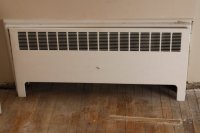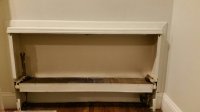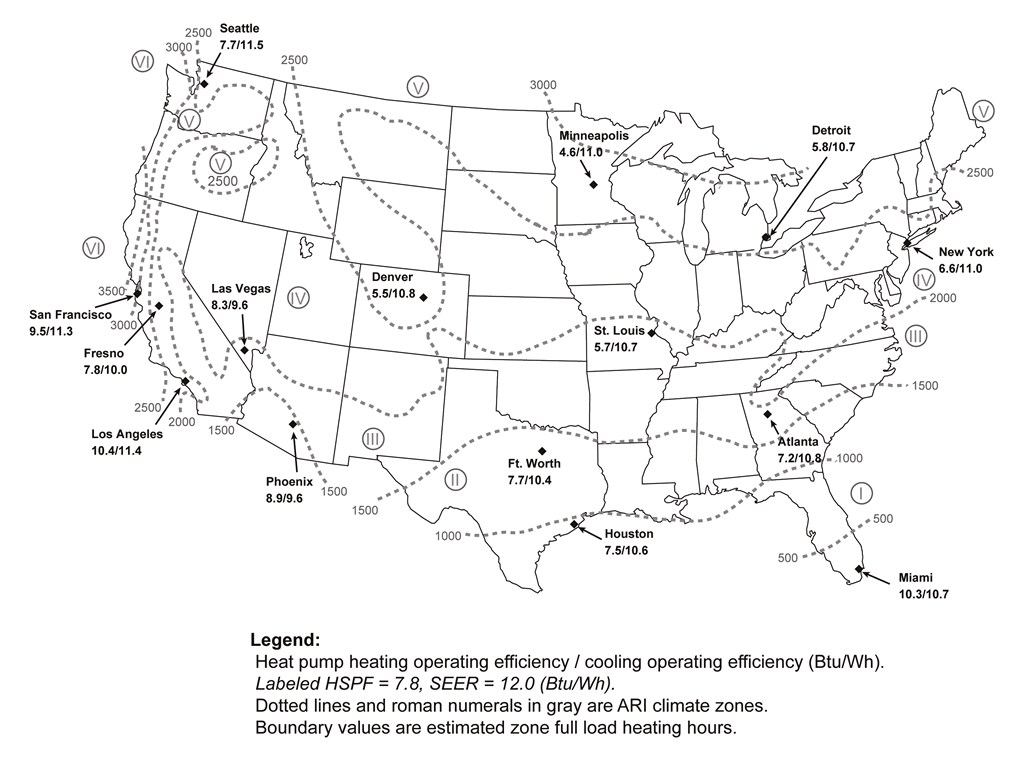Hi all,
I am a new homeowner with minimal knowledge of heating systems prior to coming across this forum last week. Thanks for all the great info. It has been tremendously helpful.
I am looking to replace my existing gas boiler with a mod con unit. I may or may not have to replace my existing indirect DHW tank (will take advice). I contacted several contractors, all provided different (over)sizing options and wide range of costs. I would like further guidance in choosing the right equipment. Any input will be much appreciated. Background:
Location: Nassau County, Long Island, NY 11791
House: Two-story split level with “half” basement, built in 1955. Energy audit was performed after moving in last month. Blower door test measured about 5000 CFM. The house is generally poorly insulated and very leaky (for instance, there is an existing 3’ x 3.5’ whole house fan vent at the ceiling of the second floor directly open to attic). Before December, at the minimum, I am looking to air seal (minimum 25% CFM reduction), and insulate attic floor. I plan to eventually air seal basement rim joists as well. Gas boiler and DHW tank are located in basement. Basement has minimal insulation.
Existing Gas Boiler: 1979 cast iron Hydrotherm HC-165 (most likely from 1980s). Input 165,000 BTU/hr. Output 130,000 BTU/hr. Energy audit company measured combustion efficiency at about 70%.
Existing DHW Tank: Appears less than 10 years old. Techtanium TT-40 Indirect Water Heater. 40 gal.
Existing Heating Zones: Two Zones – ¾” copper pipe:
Zone 1
First Floor – 29’ total (23’ of slant fin in dining room and kitchen; remaining 6’ of fin are about 6” wide enclosed in old metal crate/vent)
Second Floor – 18’ total (7’ of slant fin in bathrooms; 11’ of the older/wider fin in three bedrooms combined)
Attached Garage (uninsulated) – 11’ slant fin (recently added by previous owner)
Zone 2
Den – 10’ slant fin
Total fin length = 68’
It will be about 57’ after removing the garage loop.
Heated Areas:
Zone 1 First Floor = 580 ft2
Zone 1 Second Floor = 780 ft2
Zone 2 Den = 475 ft2
Total = 1835 ft2
Other Areas With No Heat:
Attached Garage = 380 ft2
Basement = 580 ft2
I will start with some basic observations/questions. Please feel free to comment:
1) Heating Load - Without running Manual J and past gas usage data (no access), I am not sure if I can accurately estimate load. Also old usage data may not be relevant since it does not reflect benefits of new insulation. For heating range from +15F to +65F (design), it appears heating load of 30,000 BTU/hr is a conservative starting point. A more realistic range after air seal may be in the 20,000 BTU/hr range? Median temp last winter was about 40F, so seasonal heating load is likely on the order of 10,000 to 15,000 BTU/hr?
At 1.4x oversizing of design, its still between 28,000 BTU/hr and 42,000 BTU/hr. Certainly not 80,000 BTU/hr, or even 160,000 BTU/hr that contractors suggested to me so far.
2) Minimum Fire Rate – The popular mod con choice here seems to be the HTP UFT-80W at 8000 BTU/hr minimum fire input. Operating at 120F AWT and 57’ of baseboard, they will emit about 57’ x 200 BTU/hr per ft of fin = 11,400 BTU/hr.
But how can I confirm output of the old 6” wide fin?
If I have two equal zones, it appears I will need minimum 40' fin (assuming 200 BTU/hr per ft at 120F AWT) per zone to avoid short cycling in condensing mode with HTP? How do you factor in the usage of the indirect DHW? HTP UFT-80W seems to be a good choice. However, finding an experienced local HTP installer is a bit of struggle.
3) What are the deciding factors as to whether or not to replace or keep the existing indirect DHW tank? If I have to replace the tank, which model/feature will be a good fit with the mod con?
4) Side question. Since its only function is to heat the indirect DHW as needed, how efficient do mod con boilers operate during the summer months with indirect DHW setup?
Just some basic questions for now. Just want to make sure I am on the right track. Any input will be appreciated.
Thanks,
Jerry
I am a new homeowner with minimal knowledge of heating systems prior to coming across this forum last week. Thanks for all the great info. It has been tremendously helpful.
I am looking to replace my existing gas boiler with a mod con unit. I may or may not have to replace my existing indirect DHW tank (will take advice). I contacted several contractors, all provided different (over)sizing options and wide range of costs. I would like further guidance in choosing the right equipment. Any input will be much appreciated. Background:
Location: Nassau County, Long Island, NY 11791
House: Two-story split level with “half” basement, built in 1955. Energy audit was performed after moving in last month. Blower door test measured about 5000 CFM. The house is generally poorly insulated and very leaky (for instance, there is an existing 3’ x 3.5’ whole house fan vent at the ceiling of the second floor directly open to attic). Before December, at the minimum, I am looking to air seal (minimum 25% CFM reduction), and insulate attic floor. I plan to eventually air seal basement rim joists as well. Gas boiler and DHW tank are located in basement. Basement has minimal insulation.
Existing Gas Boiler: 1979 cast iron Hydrotherm HC-165 (most likely from 1980s). Input 165,000 BTU/hr. Output 130,000 BTU/hr. Energy audit company measured combustion efficiency at about 70%.
Existing DHW Tank: Appears less than 10 years old. Techtanium TT-40 Indirect Water Heater. 40 gal.
Existing Heating Zones: Two Zones – ¾” copper pipe:
Zone 1
First Floor – 29’ total (23’ of slant fin in dining room and kitchen; remaining 6’ of fin are about 6” wide enclosed in old metal crate/vent)
Second Floor – 18’ total (7’ of slant fin in bathrooms; 11’ of the older/wider fin in three bedrooms combined)
Attached Garage (uninsulated) – 11’ slant fin (recently added by previous owner)
Zone 2
Den – 10’ slant fin
Total fin length = 68’
It will be about 57’ after removing the garage loop.
Heated Areas:
Zone 1 First Floor = 580 ft2
Zone 1 Second Floor = 780 ft2
Zone 2 Den = 475 ft2
Total = 1835 ft2
Other Areas With No Heat:
Attached Garage = 380 ft2
Basement = 580 ft2
I will start with some basic observations/questions. Please feel free to comment:
1) Heating Load - Without running Manual J and past gas usage data (no access), I am not sure if I can accurately estimate load. Also old usage data may not be relevant since it does not reflect benefits of new insulation. For heating range from +15F to +65F (design), it appears heating load of 30,000 BTU/hr is a conservative starting point. A more realistic range after air seal may be in the 20,000 BTU/hr range? Median temp last winter was about 40F, so seasonal heating load is likely on the order of 10,000 to 15,000 BTU/hr?
At 1.4x oversizing of design, its still between 28,000 BTU/hr and 42,000 BTU/hr. Certainly not 80,000 BTU/hr, or even 160,000 BTU/hr that contractors suggested to me so far.
2) Minimum Fire Rate – The popular mod con choice here seems to be the HTP UFT-80W at 8000 BTU/hr minimum fire input. Operating at 120F AWT and 57’ of baseboard, they will emit about 57’ x 200 BTU/hr per ft of fin = 11,400 BTU/hr.
But how can I confirm output of the old 6” wide fin?
If I have two equal zones, it appears I will need minimum 40' fin (assuming 200 BTU/hr per ft at 120F AWT) per zone to avoid short cycling in condensing mode with HTP? How do you factor in the usage of the indirect DHW? HTP UFT-80W seems to be a good choice. However, finding an experienced local HTP installer is a bit of struggle.
3) What are the deciding factors as to whether or not to replace or keep the existing indirect DHW tank? If I have to replace the tank, which model/feature will be a good fit with the mod con?
4) Side question. Since its only function is to heat the indirect DHW as needed, how efficient do mod con boilers operate during the summer months with indirect DHW setup?
Just some basic questions for now. Just want to make sure I am on the right track. Any input will be appreciated.
Thanks,
Jerry






